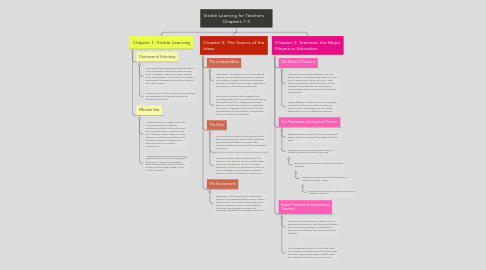
1. Chapter 1: Visible Learning
1.1. Outcomes of Schooling
1.1.1. Make learning something that the kids want to do for themselves rather than what we want them to achieve. Make the students want to strive for greatness. Allow them to be visible to teaching and learning and have them become their own teachers .
1.1.2. Schooling should not only focus on knowledge and information but learned aspects like morals and character.
1.2. Effective Size
1.2.1. An effective size is a useful method for comparing results on different measures whether that be test scores from the state level or teacher-made test. Teachers make a difference in the classroom and by having effective size, this allows relative comparisons on varies influences on student achievement.
1.2.2. Visible learning occurs when learning is explicit, transparent and challenging to the students. It becomes powerful when teachers take on the role of the learner and the students take on the role of the teacher.
2. Chapter 3: Teachers: the Major Players in Education
2.1. The Belief of Teachers
2.1.1. Teachers learning styles, attitudes and their natural love of schooling helps determine what kind of teacher you are going to be. Many factors play into this decision but all of these variables helps teachers become positive change agents with a commitment to student achievement.
2.1.2. Highly effective teachers show d=0.25 growth in student performance which is relative to almost a year's advantage over their peers that would be in a low-effective classroom.
2.2. The Passionate and Inspired Teacher
2.2.1. Expert teachers can identify the most important ways in which to represent the subject that they teach
2.2.2. Expert teachers are proficient at creating an optimal classroom climate for learning
2.2.2.1. Expert teachers monitor learning and provide feedback
2.2.2.1.1. Expert teachers believe that all students can reach the success criteria
2.3. Expert Teachers vs Experiences Teachers
2.3.1. What sets the expert teachers apart from the experiences teachers is that the expert teachers had a greater percentage of surface-level achievement outcomes and were more adept to depth.
2.3.2. The experienced teachers on the other hand had a deeper understanding of the knowledge and had a higher percentage of depth rather then surface-level achievement outcomes.
3. Chapter 2: The Source of the Ideas
3.1. The evidence Base
3.1.1. Homework: Is it effective or should we rethink what we give students in the primary grades? The evidence suggest that homework plays a small role in student achievement, especially in the primary or elementary grade levels.
3.1.2. Secondary Students: Hattie suggests that secondary grades and up are most impacted by homework due to the engagement at which they can concentrate and focus on what they are doing. It suggested they are less likely to get distracted and have better self regulation and more effective study habits.
3.2. The Story
3.2.1. The story behind visible learning occurs when there are specific goal attained with deliberate and productive feedback. This will allow students, teachers and peers alike to participate in learning.
3.2.2. Teachers see two different directions in the classroom that sets the tone for whether there is learning taking place or not. This allows teachers to reflect and alter there direction of how to develop new strategies for different learners so that all students can find success.
3.3. The Environment
3.3.1. By having a safe community, this allows the student to feel safe when they make a mistake. Children don't like to fail but by building this safe environment for them in the classroom, this fosters learning from mistakes and listening to feedback from teachers and peers.
